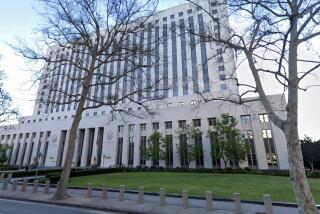Another death in the dark hours
I was still awake at 12:16 a.m. Wednesday when the process of dying began at San Quentin prison for Donald Beardslee.
It was never my intention, at least not consciously, to remain up to observe in some small way the execution of a man who had murdered three other human beings.
I knew that his last appeal had failed and that the governor had refused to grant a pardon. I knew that Beardslee’s dying was to commence one minute after midnight, a time set by the precision-oriented nature of legal executions.
The process faltered when those assigned to connect him to the chemicals that would take his life were unable, for some reason, to do so. Then, 15 minutes after the assigned time of his death, the dying began, and at 12:29 a.m., it was over.
The next morning, I telephoned James Currie to ask if Beardslee was one of the death row inmates whose lives he had fought to save. He wasn’t. I didn’t press the point because I could tell by the tone in his voice that this may have been a time when the nightmares of his old profession were setting in again.
A former jazz drummer with a master’s degree in psychology, Currie retired four years ago as a death penalty investigator for the Orange County public defender’s office. His job, in effect, was to search every element of the backgrounds of those found guilty of murder in an effort to keep them from the death chamber. He was the advocate for 20 convicted killers, searching for reasons that would spare them. None of the 20 has been executed. Four are currently on death row.
In a recent visit to his home on a quiet street in the city of Orange, I sat with Currie for an hour or so and talked about, well, death.
He is a fierce opponent of capital punishment, based partly on the caprice of having decisions about who should die rest with the “uninformed and vindictive public” from which jury panels are drawn, and on the inhumanity of a culture that has not evolved beyond legal murder.
“I share with you,” he wrote me earlier, “the sadness, tinged with outrage and shame, at being a member of a society that cannot get past the need for revenge. And, along with that, I internally rail because I know how flawed the justice system is.”
A trim and youthful 60, Currie is a man not given to high emotion. But he admits to nightmares during the years that he exposed himself to what has been called “a crime that screams,” and to the knowledge that many, too deranged to even know the consequences of their acts, could be put to death by lethal injection.
The execution of Beardslee is likely to cause the bad dreams anew. Much of Currie’s investigative work went into seeking the humanity in the core of those who murdered. I suspect he is thinking about that in Beardslee’s case, wondering at the flawed chemistry that caused a man to turn killer.
“My job back then was to determine who the person was,” he said to me as we sat in a room surrounded by hundreds of old long-playing records and compact discs. There is an electronic set of drums in his bedroom, connected to imported speakers the size of tubas, and a traditional set of drums in the garage. Music remains an essential part of his life, existing in odd juxtaposition to the job he eventually took as a hunter for circumstances that would fit into a profile of mercy.
Currie cites one example of what he had been able to accomplish, a journey that lasted two years.
A homeless man had been convicted of murdering an elderly woman who had lived only a mile from Currie’s home. The jury had found no extenuating circumstances, and the likelihood was that he would be sentenced to death.
The man had been the child of an affair between a married white woman and an African American man. For the first year of his life, he had been locked in a back room of the woman’s home as an object of shame, and then was given up for adoption.
His behavior became increasingly bizarre, and he was later diagnosed as paranoid schizophrenic. He blamed his adoptive mother for his fate and left home in a rage. Currie discovered that the woman he eventually murdered was an exact double for the surrogate parent he had come to hate. In the warped delusion that controlled the moment of his crime, he was killing his mother when he murdered the old lady.
“The man’s level of mental competence was so low, he couldn’t even help his own case,” Currie says. “The jury decided he was definitely crazy but had ‘a window of sanity’ when he committed the crime.” Currie shakes his head in remembered disbelief. “A window of sanity,” he says again. “What in the hell is that?”
At least partly because of Currie’s work, the man was spared death and has been incarcerated for life in one of the state’s mental institutions.
Whether a convicted felon is executed depends on the political climate in which he’s convicted, Currie says. “Commit the crime in the wrong decade, and you die. During a moratorium, you don’t. It’s too whimsical for me.”
Beardslee’s execution was the first in California in three years. He’s the 11th inmate put to death since California reinstated the death penalty in 1978. Do I mourn for them? Only because, as the poet John Donne put it, they were a part of the whole. In that sense, I mourn for us all.
Al Martinez’s column appears Mondays and Fridays. He can be reached at al.martinez @latimes.com.
More to Read
Sign up for Essential California
The most important California stories and recommendations in your inbox every morning.
You may occasionally receive promotional content from the Los Angeles Times.






